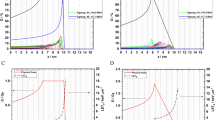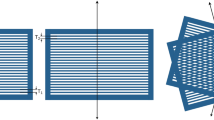Abstract
A new treatment planning system (TPS) was designed and developed for a new treatment system, which consisted of a micro-beam-enabled linac with robotics and a real-time tracking system. We also evaluated the effectiveness of the implemented algorithms of optimization and dose calculations in the TPS for the new treatment system. In the TPS, the optimization procedure consisted of the pseudo Beam’s-Eye-View method for finding the optimized beam directions and the steepest-descent method for determination of beam intensities. We used the superposition-/convolution-based (SC-based) algorithm and Monte Carlo-based (MC-based) algorithm to calculate dose distributions using CT image data sets. In the SC-based algorithm, dose density scaling was applied for the calculation of inhomogeneous corrections. The MC-based algorithm was implemented with Geant4 toolkit and a phase-based approach using a network-parallel computing. From the evaluation of the TPS, the system can optimize the direction and intensity of individual beams. The accuracy of the dose calculated by the SC-based algorithm was less than 1 % on average with the calculation time of 15 s for one beam. However, the MC-based algorithm needed 72 min for one beam using the phase-based approach, even though the MC-based algorithm with the parallel computing could decrease multiple beam calculations and had 18.4 times faster calculation speed using the parallel computing. The SC-based algorithm could be practically acceptable for the dose calculation in terms of the accuracy and computation time. Additionally, we have found a dosimetric advantage of proton Bragg peak-like dose distribution in micro-beam treatment.

















Similar content being viewed by others
References
Ding GX, Duggan DM, Lu B, Hallahan DE, Cmelak A, Malcolm A, Newton J, Deeley M, Coffey CW. Impact of inhomogeneity corrections on dose coverage in the treatment of lung cancer using stereotactic body radiation therapy. Med Phys. 2007;34:2985–94.
Van Esch A, Tillikainen L, Pyykkonen J, Tenhunen M, Helminen H, Siljamäki S, Alakuijala J, Paiusco M, Lori M, Huyskens DP. Testing of the analytical anisotropic algorithm for photon dose calculation. Med Phys. 2006;33:4130–48.
Kan MW, Cheung JY, Leung LH, Lau BM, Yu PK. The accuracy of dose calculations by anisotropic analytical algorithms for stereotactic radiotherapy in nasopharyngeal carcinoma. Phys Med Biol. 2011;56:397–413.
Pugachev A, Xing L. Pseudo beam’s-eye-view as applied to beam orientation selection in intensity-modulated radiation therapy. Int J Radiat Oncol Biol Phys. 2001;51:1361–70.
Memorial Sloan-Kettering Cancer Center. A Practical Guide to Intensity-Modulated Radiation Therapy. Madison: Medical Physics Publishing; 2003. p. 53–58.
Mackie TR, Scrimger JW, Battista JJ. A convolution method of calculating dose for 15MV X-rays. Med Phys. 1985;12:188–96.
Siddon RL. Fast calculation of the exact radiological path for a three-dimensional CT array. Med Phys. 1985;12:252–5.
Schneider W, Bortfeld T, Schlegel W. Correlation between CT numbers and tissue parameters needed for Monte Carlo simulations of clinical dose distributions. Phys Med Biol. 200;45:459–78.
Bazalova M, Graves EE. The importance of tissue segmentation for dose calculations for kilovoltage radiation therapy. Med Phys. 2011;38:3039–49.
Bush K, Popescu IA, Zaygorodni S. A technique for generating phase-space-based Monte Carlo beamlets in radiotherapy applications. Phys Med Biol. 2008;53:N337–47.
ESTRO Booklet No.7. Quality assurance of treatment planning systems. Practical examples for non-IMRT photon beams. 2004
Japanese Society of Medical Physics Task Group 01. Quality Assurance of Treatment Planning Systems for X-ray Beams. Igakubutsuri. 2008; vol 27. p. 39–58.
Bragg CM, Wingate K, Conway J. Clinical implications of the anisotropic analytical algorithm for IMRT treatment planning and verification. Radiother Oncol. 2008;86:276–84.
Acknowledgments
This study was supported by New Energy and Industrial Development Organization, Japan (NEDO).
Author information
Authors and Affiliations
Corresponding author
About this article
Cite this article
Tachibana, H., Kojima, H., Yusa, N. et al. Design and development of a new micro-beam treatment planning system: effectiveness of algorithms of optimization and dose calculations and potential of micro-beam treatment. Radiol Phys Technol 5, 186–198 (2012). https://doi.org/10.1007/s12194-012-0153-6
Received:
Revised:
Accepted:
Published:
Issue Date:
DOI: https://doi.org/10.1007/s12194-012-0153-6




